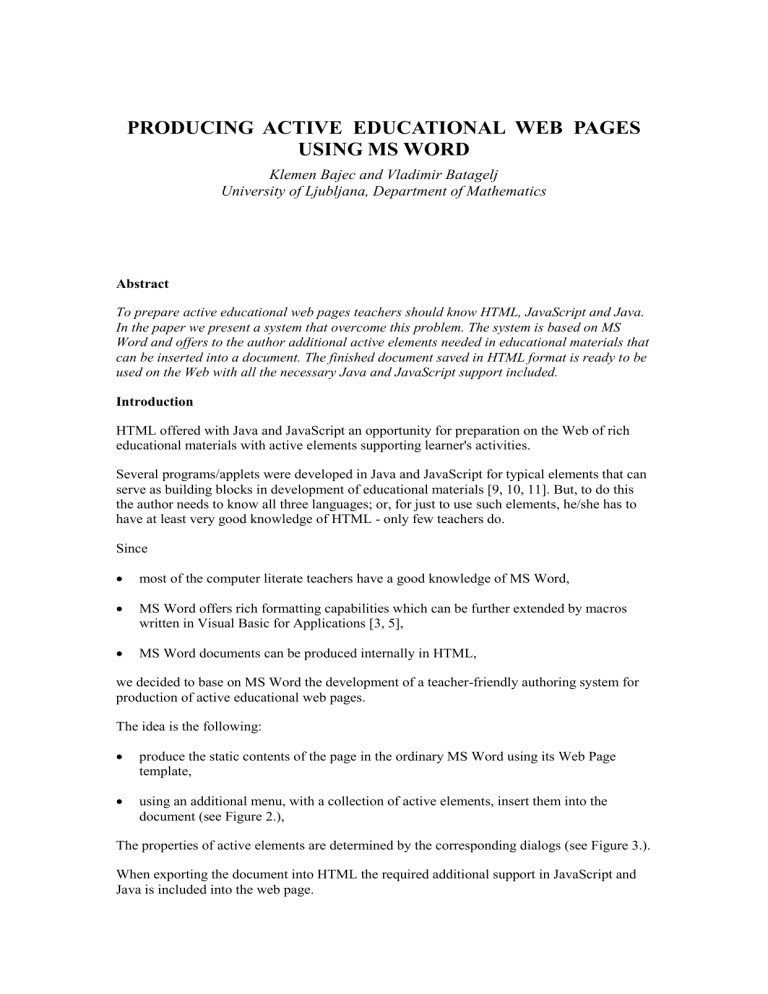Producing active educational web pages using ms Word

PRODUCING ACTIVE EDUCATIONAL WEB PAGES
USING MS WORD
Klemen Bajec and Vladimir Batagelj
University of Ljubljana, Department of Mathematics
Abstract
To prepare active educational web pages teachers should know HTML, JavaScript and Java.
In the paper we present a system that overcome this problem. The system is based on MS
Word and offers to the author additional active elements needed in educational materials that can be inserted into a document. The finished document saved in HTML format is ready to be used on the Web with all the necessary Java and JavaScript support included.
Introduction
HTML offered with Java and JavaScript an opportunity for preparation on the Web of rich educational materials with active elements supporting learner's activities.
Several programs/applets were developed in Java and JavaScript for typical elements that can serve as building blocks in development of educational materials [9, 10, 11]. But, to do this the author needs to know all three languages; or, for just to use such elements, he/she has to have at least very good knowledge of HTML - only few teachers do.
Since
most of the computer literate teachers have a good knowledge of MS Word,
MS Word offers rich formatting capabilities which can be further extended by macros written in Visual Basic for Applications [3, 5],
MS Word documents can be produced internally in HTML, we decided to base on MS Word the development of a teacher-friendly authoring system for production of active educational web pages.
The idea is the following:
produce the static contents of the page in the ordinary MS Word using its Web Page template,
using an additional menu, with a collection of active elements, insert them into the document (see Figure 2.),
The properties of active elements are determined by the corresponding dialogs (see Figure 3.).
When exporting the document into HTML the required additional support in JavaScript and
Java is included into the web page.
An authoring system based on MS Word
Our system is still in the phase of a prototype. What should be its main capabilities? Here is a list of features contained in the current version:
Figure 1. Some quiz elements
formatting and inclusion of multimedia (pictures, sounds, videos) is handled by MS
Word,
the main group of active elements supported by the system, are so called quiz elements
(list selection, switches, yes/no selection, holes, free text answer; see Figure 1),
additional active elements include: function graph drawing, calculator, dynamic GIF controller, …
active elements can be linked to detectives and evaluators . They are collecting trace information and preparing evaluations of learner activities,
the system can also use e-mail or WWW-server support to collect information about the progress of learners.
Implementation details
The procedures to support active web elements are written in JavaScript and Java, and bundled in some libraries. The authoring system is essentially an extension of MS Word Web
Page template. It adds a collection of MS Word macros that support the insertion the active elements.
We are using MS Word 7.0 and assume a HTML 4 browser with JavaScript 1.2.
Let us illustrate the necessary steps on the case of holes.
Extending Web Page template we first create, by Tools / Customize / Toolbars / New a new menu Insert Interactive Element and provide an entry in it for each type of active elements – see Figure 2.
Figure 2. Menu of interactive elements
Each entry is linked to a corresponding dialog (Figure 3.) by which the author determines the properties of the active element.
Figure 3. Dialog for holes
The macros attached to the dialog collect the information provided by the author and when done, a special macro inserts the corresponding description into a document. This description consists of two parts: MS Word representation of the active element (see Figure 4.), and
HTML / JavaScript code (inside <script> tag) for web browsers.
Figure 4. MS Word representation of a hole
MS Word ignores the code inside <script> tags; while JavaScript aware web browsers ignore the code inside <noscript> tags.
In Figure 5. we can see the holes in action.
Figure 5. Holes in action
Each active element is supported by a JavaScript or Java procedure (a procedure hole in our case) which is in fact a constructor for an object servicing the inserted element.
The described authoring system can be easily extended to cover other types of interactive elements.
The proposed authoring system, without additional security enhancements and organizational solutions, can be mainly used for production of educational materials for self-education.
The current version of the authoring system and related materials will be available at http://www.educa.fmf.uni-lj.si/izodel/dela/author/default.htm
Conclusion
We believe that the teachers themselves should be the main producers of educational materials and that the programmers should provide them with cheap, powerful and easy to use development tools. Our system is a step in this direction.
Acknowledgement
This work was supported by the Ministry of Education of Slovenia, Project Ro .
References
1.
Barker P (1993) Exploring Hypermedia . Kogan Page, London.
2.
Druin A and Solomon C (1996) Designing Multimedia Environments for Children .
Wiley, New York.
3.
Getz K and Gilbert M (1997) VBA Developer's Handbook . Sybex, San Francisco.
4.
Hribar P (1998) HTML 4.0
. Flamingo, Nova Gorica.
5.
Pretnjak M (1998) Visual Basic za Aplikacije . Desk, Izola.
6.
Sharp V (1996) Computer Education for Teachers . Brown &Benchmark, Chicago.
7.
Solomon C (1997) Microsoft Office 97 Developer's Handbook . Microsoft Press,
Redmond, Washington.
8.
(1997) S programom Microsoft Word 97 do uspeha . Microsoft Corporation, Ljubljana.
9.
developer.com
JavaScript http://www.developer.com/directories/pages/dir.javascript.html
10.
developer.com
Java http://www.developer.com/directories/pages/dir.java.html/
11.
Dremelj R (1996) Functions http://www.educa.fmf.uni-lj.si/izodel/dela/netbook/funkcije/funkcije.html
Authors:
Klemen Bajec and Prof. Vladimir Batagelj
University of Ljubljana, FMF, Department of Mathematics
Jadranska 19, 1000 Ljubljana, Slovenia
E-mail : klemen.bajec@fmf.uni-lj.si
, vladimir.batagelj@uni-lj.si
